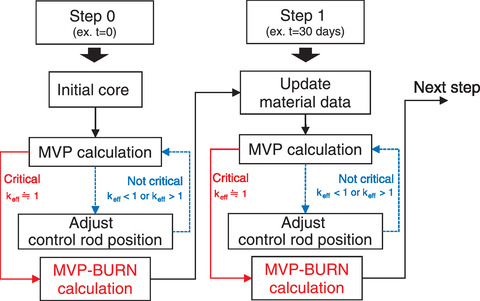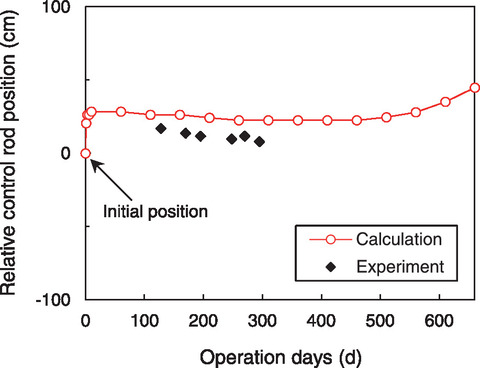
Fig.6-17 Flow chart of the utility tool

Fig.6-18 Pressure variation of metal lattices of YH3
The criticality control rod position, which can directly be measured during the operation, is one of the important parameters in confirming the validity of the nuclear characteristic evaluation method. However, in the conventional calculation of the critical control rod position, the critical calculation must be manually performed many times to find the critical position of the control rod, which requires a large amount of calculation work time. In addition, the fuel composition changes during the burnup process; thus, searching for the critical control rod position while exchanging the fuel composition is also necessary, leading to a huge challenge. For example, when using a Monte Carlo code (e.g., MVP) to evaluate the nuclear characteristics of the high temperature engineering test reactor (HTTR), it takes more than 1 week to calculate the critical control rod position during the entire burnup period. Therefore, we developed a utility tool that can automatically search for the critical control rod positions to reduce the calculation work time and perform highly accurate calculations.
Fig.6-17 depicts the utility tool algorithm. First, the tool calculates keff using the MVP code with any initial value of the control rod position. Once the MVP calculation finishes, the tool checks whether or not the critical state is achieved (keff ≒ 1). When the reactor is not critical (keff < 1 or keff > 1), the tool will re-adjust the control rod position and repeat the MVP calculation until the reactor becomes critical. When the keff reaches nearly unity (within a specific range), the control rod position is recorded, and the MVP-BURN calculation is performed with the designated power and operation time. Subsequently, the nuclide density that has changed as the fuel burns is read and updated to perform the calculation for the next step. As in the previous steps, the tool will automatically then search for the next critical control rod position and repeat the next calculation until the specified burnup.
Conventionally, the control rod was set at a fixed position during the entire burnup because the amount of calculation is enormous; however, with this utility tool, the critical control rod is always calculated. Therefore, the reactor operation can be more realistically simulated. In addition, the calculation working time can be reduced to less than 2 days by automating all calculation procedures, such as searching for the critical control rod position, updating the nuclide density, and submitting the calculation job to the computing system. The time reduction with the new tool gives a great advantage in developing more detailed calculation models.
Fig.6-18 shows the change in the critical control rod position during operation of the HTTR. The result confirmed that the calculated critical control rod position using this utility tool was in a good agreement with the measurement, with approximately 5% difference from the experimental positions.
The abovementioned results confirmed that the utility tool can accurately evaluate the critical control rod position of the HTTR, automate the complicated work required for the calculation, and reduce the calculation work time by approximately one-third. In the future, by utilizing this utility tool, we can develop more detailed calculation models, which can contribute to the improvement of the accuracy of the neutronic calculations of the HTTR. In addition, the utility value of this tool is expected to increase in the future because the calculation method can be applied not only to the HTTR, but also to other nuclear reactors.
(Hai Quan Ho)
<Previous: 6-6 | Next: 7 Research and Development of Fast Reactors>